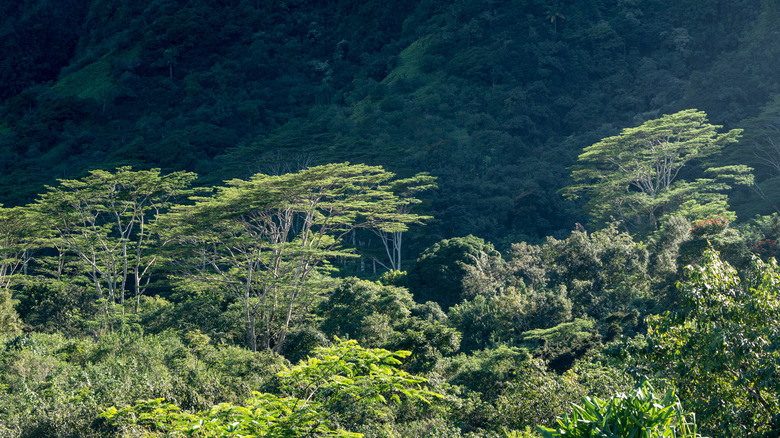The Differences Between A Monkeypod And An Albizia Tree
The Hawaiian islands have a variety of beautiful trees, both native and recently introduced. While neither the monkeypod tree (Samanea saman) nor the Moluccan albizia (Falcataria falcata) are native to the islands, they have both become ubiquitous there. Monkeypod trees, which are also sometimes called rain trees, and Moluccan albizia trees are in the same family, Fabaceae. While some have considered them part of the albizia genus, that is not how they are generally categorized today. Knowing the difference between monkeypods and Moluccan albizias is essential to make sure you're not accidentally growing the dangerous or invasive albizia tree. While the species look similar at first glance, they have distinct differences in invasiveness, uses, and appearance.
The Moluccan albizia is only hardy in USDA zones 10 and 11, while monkeypods are hardy in zones 9 through 13. This means that growers in many southern parts of the continental United States can enjoy monkeypods, while fewer have the climate required for Moluccan albizia. If you find a similar-looking tree in a colder zone, it may be a mimosa or silk tree (Albizia julibrissin). Silk trees are hardy in zones 6 through 9 and are in the same family as Moluccan albizias and monkeypod trees. They generally stay smaller than their relatives, with a maximum height of around 40 feet. Like monkeypods and Moluccan albizia, silk trees have gorgeous flowers, generally in pink or white. Despite their beauty, you may want to rethink growing mimosa trees, as they can become invasive.
The invasiveness and uses of monkeypods and albizias
Moluccan albizias, unlike monkeypod trees, can cause major issues due to their invasive and aggressive nature, as well as their brittleness. Relatively mild winds can cause the albizia's huge branches to break, leading to damaged architecture, massive economic costs, and even injuries. In the Hawaiian islands, they regularly outcompete native trees and plants and can alter Hawaii's delicate rainforest ecosystems. Further, they can also add lots of nitrogen to the soil, which could negatively affect other growing plants.
On the other hand, monkeypod trees have a low risk for invasiveness (even in Hawaii) and can make great ornamental landscape trees in areas with enough space. Monkeypod trees have a variety of uses as well, as their wood is often used in carvings, their seeds are used to make leis, and their edible pods are said to taste similar to licorice. Monkeypod trees do have downsides though, particularly if they aren't given enough room, as their large root systems can cause damage to lawns and sidewalks.
Sizes and visual differences between monkeypod and albizia trees
Monkeypods and Moluccan albizias are both impressively large and fast-growing trees, with monkeypods reaching heights of over 50 feet and albizias often growing as tall as 100 feet. Albizia trees are naturally fast-growing, but when they grow in Hawaii, they may be the fastest-growing trees in the world, putting on up to 15 feet of growth in a year. Monkeypods, on the other hand, grow at a rate closer to 3 feet a year. Both trees have oblong bipinnately-compound leaves, though the Moluccan albizia's leaves don't close at night the way the monkeypod's leaves do.
Both monkeypods and albizias have beautiful flowers with similar shapes, but they can be easily distinguished by color. Monkeypod flowers are pink, as opposed to albizia flowers, which are generally white or green. Both trees also both have wide canopies, though monkeypod trees are generally wider and more dome-shaped, reaching spreads of 100 feet, while albizia's spread is usually closer to 50 feet. This gives them somewhat different shapes, with albizia trees generally being more vase or columnar-shaped, as opposed to the wide canopies of the monkeypods.


